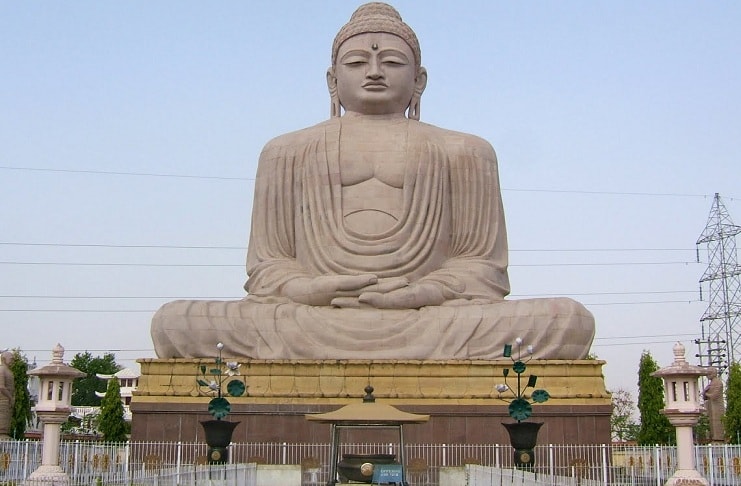Last Updated on 16/12/2023
Spiritual Sojourns
The centre of the Buddhist Universe, Bodh Gaya helps one understand the message of the enlightened one.
We stood amid the ruins of an ancient Stupa that rested like a crumpled crown on the summit of a little mound that overlooked the dry Falgu River. And as dusk cast its veil like a soothing balm over the sun-scorched land, the sand of the riverbed started to glow with an almost mysterious golden-yellow hue. A little shrine perched on the banks of the river was bathed in fluorescent light and shimmered like a beacon for souls lost in the vast sea of sand.
Popular legend has it that this shrine stands on the very spot where Prince Siddhartha bid farewell to the five disciples who had accompanied him through his six years of penance and meditation. Dejected by the fact that he had still not unlocked the mysteries of life and human suffering, he pleaded with them to leave him alone. Soon after they had departed, the young prince sat down for his first meal in six years, offered to him by an old lady who lived in a hut close by. He then crossed the sandy stretch, a frail skeleton-like figure trudging across the barren riverbed to the forest on the other side.

That night as Prince Siddhartha mediated on a bundle of straw under a bodhi tree the earth heaved and a slab of polished stone emerged directly under him. And that night he attained enlightenment and was reborn as Lord Buddha. Today, the forest has been transformed into a sprawling temple complex around which the pilgrim town of Bodh Gaya and indeed the entire world revolves. For Bodh Gaya is the centre of the earth… or so Buddhists believe; for it is here that the religion traces its origins.
The Mahabodhi Temple Complex (a UNESCO World Heritage Site) comprises manicured gardens and shrines that surround the towering Stupa within which is the larger-than-life gilded statue of the Buddha. We looked at the bejeweled sage and could not help but muse on the paradox that he was being showered with the earthly treasure that he had renounced in his life. That was till we saw a group f devotees, elderly men and women, walk past in single file. The simple unquestioning devotion that radiated from eyes that gazed out of their parched ad wrinkled faces was a fitting rebuttal to our skepticism.
We lowered our cameras and meditated on the Buddha and his message. For a brief moment, we were cocooned in a void, away from the hustle and bustle of pilgrim around us… indeed, the world itself seemed to go into a prolonged spasm as we felt the Buddha reach out through the centuries and touch us. The moment of infinity was brief before we were dragged back once more to the raucous reality of the pilgrims around us.
We joined the river of pilgrims as they circled the main stupa, stopping to offer prayers and seek the blessing of the Lord at the number of smaller shrines and gilded statues that grace the complex. After admiring the bodhi tree under which Lord Buddha attained spiritual liberation (the one today is believed to have sprung from the roots of the original tree), we set off to explore the town which was studded with monasteries that reflected the architectural flair of the nations that built them: Japan, China, Thailand, Tibet, Sri Lanka…. Indeed, they gave Bodh Gaya the feel of a miniature global village them park. Our final stop was at the giant 80 ft Japanese statue of the Buddha before we retired for the night. Yes, Bodh Gaya was our first stop on a spiritual journey that traced the footsteps of the Buddha as he progressed from birth in Lumbini across the border in Nepal to Kushinagar where he discarded his earthly body and attained Mahaparinirvan. In many ways it was an awakening of sorts: our personal journey of enlightenment.
On the Buddhist Trail
- The Mahaparinirvan Special Train, run by Indian Railways stops at the most important places on the Buddhist pilgrim circuit as it chugs across the plains of Central India.
- The eight-day / seven-night journey which starts and ends in Delhi covers the four main sites that are a must on any in-the-footsteps-of-the-Buddha itinerary: Lumbini where Buddha was born, Bodh Gaya where he attained enlightenment, Shravasti where he spent 25 of the 45 monsoon seasons after enlightenment and Kushinagar where he discarded his earthly body.
- It also includes a number of other Buddhist pilgrim sites as well as the Hindu pilgrim town of Varanasi and Agra, the home of the Taj Mahal.
Suggested Tours


 Call
Call WhatsApp
WhatsApp Enquiry
Enquiry